小学英语人教PEP新版六年级上册知识点
人教版新版PEP小学六年级上册英语语法表
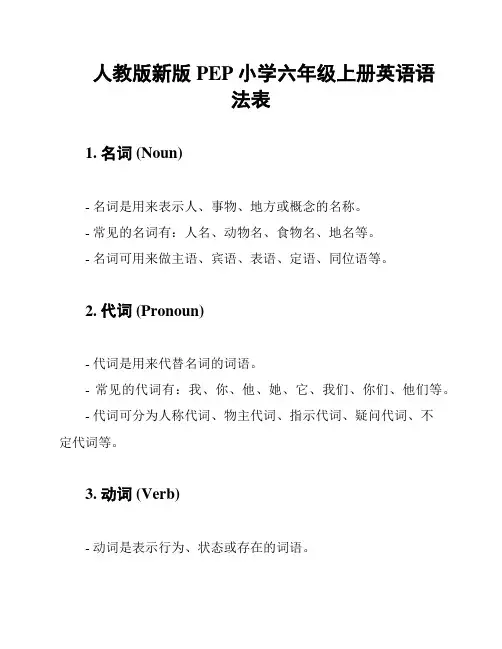
人教版新版PEP小学六年级上册英语语法表1. 名词 (Noun)- 名词是用来表示人、事物、地方或概念的名称。
- 常见的名词有:人名、动物名、食物名、地名等。
- 名词可用来做主语、宾语、表语、定语、同位语等。
2. 代词 (Pronoun)- 代词是用来代替名词的词语。
- 常见的代词有:我、你、他、她、它、我们、你们、他们等。
- 代词可分为人称代词、物主代词、指示代词、疑问代词、不定代词等。
3. 动词 (Verb)- 动词是表示行为、状态或存在的词语。
- 动词分为实义动词和虚义动词,实义动词可以独立构成句子的谓语。
- 动词还可以根据时态、语态、语气等形式进行变化。
4. 形容词 (Adjective)- 形容词是用来描述名词的特点和性质的词语。
- 形容词通常位于名词前面作定语。
- 形容词可以比较级和最高级,并可根据名词的性质进行变化。
5. 副词 (Adverb)- 副词是用来修饰动词、形容词和其他副词的词语。
- 副词可以回答疑问词how、when、where等问题的词语。
- 副词可用来修饰句子和句子的成分。
6. 冠词 (Article)- 冠词是表示名词特指与泛指的词语。
- 冠词分为定冠词和不定冠词,定冠词包括"the",不定冠词包括"a"和"an"。
- 冠词用来限定名词的范围和数量。
7. 介词 (Preposition)- 介词是用来表示名词与其他词之间关系的词语。
- 常见的介词有:in、on、at、above、below等。
- 介词通常位于名词或代词的前面。
8. 连词 (Conjunction)- 连词是用来连接句子、词语或词组的词语。
- 常见的连词有:and、but、or、so等。
- 连词可以连接并列关系、选择关系、原因和结果关系等。
9. 数词 (Numeral)- 数词是用来表示数量的词语。
- 数词分为基数词和序数词,基数词用来表示数量的多少,序数词用来表示次序和顺序。
人教版(PEP)小学英语六年级上册知识点归纳
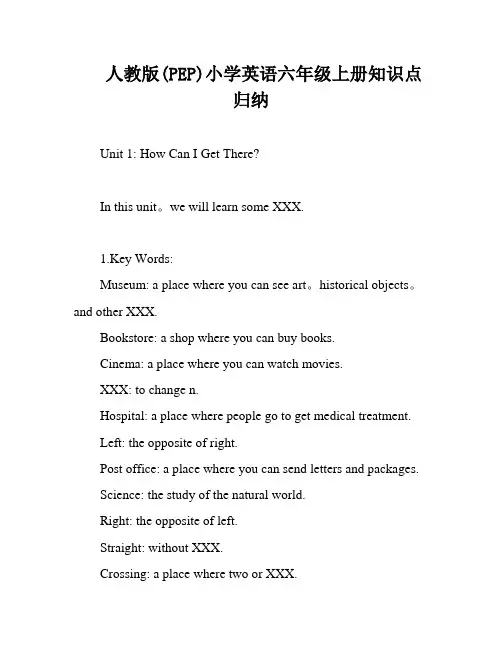
人教版(PEP)小学英语六年级上册知识点归纳Unit 1: How Can I Get There?In this unit。
we will learn some XXX.1.Key Words:Museum: a place where you can see art。
historical objects。
and other XXX.Bookstore: a shop where you can buy books.Cinema: a place where you can watch movies.XXX: to change n.Hospital: a place where people go to get medical treatment.Left: the opposite of right.Post office: a place where you can send letters and packages.Science: the study of the natural world.Right: the opposite of left.Straight: without XXX.Crossing: a place where two or XXX.eful Phrases:Post office: "Where is the post office?"Science museum: "Where is the science museum?"Pet hospital: "Where is the pet hospital?"XXX: "Where is XXX?"XXX: "Where is Beihai Park?"Palace Museum: "Where is the Palace Museum?"Go straight: "Go straight and you will see the bookstore on your left."Turn right/left: "Turn right at the crossing and you will see the hospital on your right."Next to: "The cinema is next to the bookstore."In front of: "The school is in front of the park."Near the park: "XXX is near the park."XXX: "XXX."mon ns:Excuse me: "Excuse me。
最新人教版PEP英语六年级上册知识点归纳
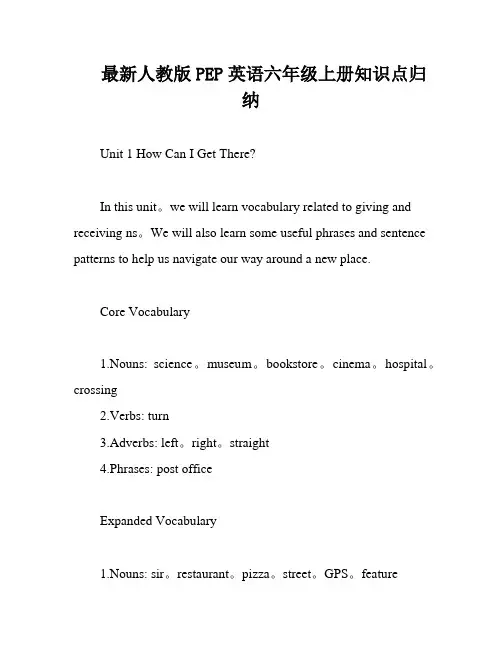
最新人教版PEP英语六年级上册知识点归纳Unit 1 How Can I Get There?In this unit。
we will learn vocabulary related to giving and receiving ns。
We will also learn some useful phrases and sentence patterns to help us navigate our way around a new place.Core Vocabulary1.Nouns: science。
museum。
bookstore。
cinema。
hospital。
crossing2.Verbs: turn3.Adverbs: left。
right。
straight4.Phrases: post officeExpanded Vocabulary1.Nouns: sir。
restaurant。
pizza。
street。
GPS。
feature2.Verbs: ask。
get。
gave。
follow。
tell3.Adjectives: interesting。
Italian。
farSentence Patterns1."Where is the ____?" - "It's next to the ____."2."How can we get there?"3."Turn left/right at the _____。
Then turn left/right at the _____."Note: Be mindful of ns and their fixed phrases.Useful Phrases1."Is there a ____?"2."There is a ____ under the ____."3."There be" sentence pattern - "There is/are ____." (Remember the principle of proximity.)By learning and practicing these vocabulary words。
人教版PEP三起小学英语六年级上册知识点总结
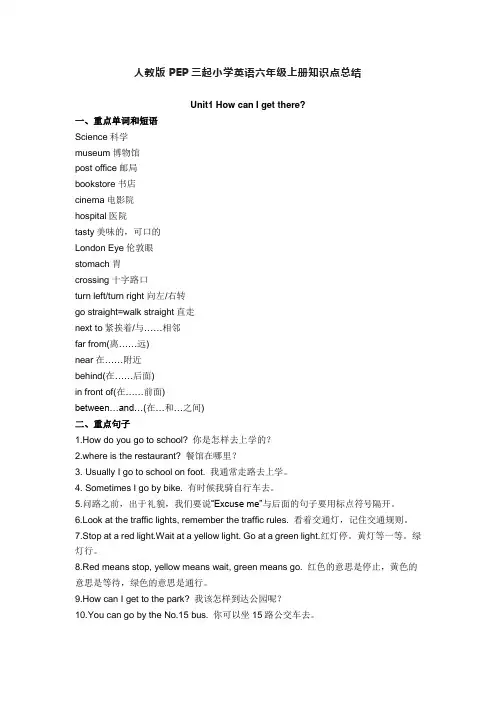
人教版PEP三起小学英语六年级上册知识点总结Unit1 How can I get there?一、重点单词和短语Science科学museum博物馆post office邮局bookstore书店cinema电影院hospital医院tasty美味的,可口的London Eye伦敦眼stomach胃crossing十字路口turn left/turn right向左/右转go straight=walk straight直走next to紧挨着/与……相邻far from(离……远)near在……附近behind(在……后面)in front of(在……前面)between…and…(在…和…之间)二、重点句子1.How do you go to school? 你是怎样去上学的?2.where is the restaurant? 餐馆在哪里?3. Usually I go to school on foot. 我通常走路去上学。
4. Sometimes I go by bike. 有时候我骑自行车去。
5.问路之前,出于礼貌,我们要说“Excuse me”与后面的句子要用标点符号隔开。
6.Look at the traffic lights, remember the traffic rules. 看着交通灯,记住交通规则。
7.Stop at a red light.Wait at a yellow light. Go at a green light.红灯停。
黄灯等一等。
绿灯行。
8.Red means stop, yellow means wait, green means go. 红色的意思是停止,黄色的意思是等待,绿色的意思是通行。
9.How can I get to the park? 我该怎样到达公园呢?10.You can go by the No.15 bus. 你可以坐15路公交车去。
新版PEP小学英语六年级上册1-6单元知识点总结
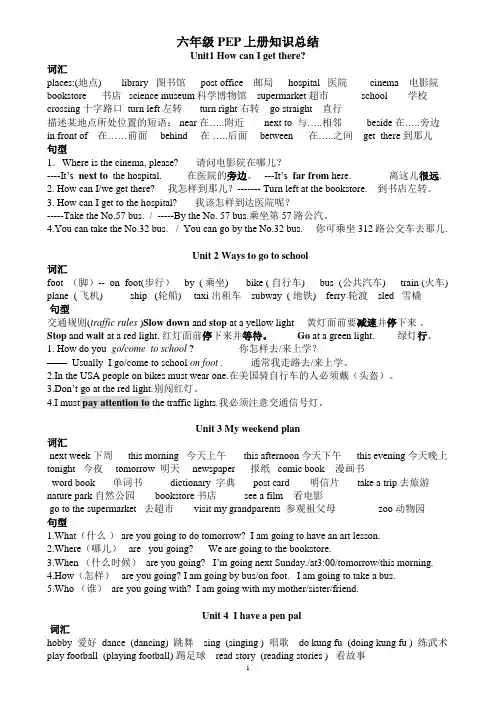
六年级PEP上册知识总结Unit1 How can I get there?词汇places:(地点) library 图书馆 post office 邮局 hospital 医院 cinema 电影院bookstore 书店 science museum科学博物馆 supermarket 超市 school 学校crossing 十字路口 turn left 左转 turn right 右转 go straight 直行描述某地点所处位置的短语: near 在…..附近 next to 与…..相邻 beside 在…..旁边in front of 在……前面 behind 在…..后面 between 在…..之间 get there 到那儿句型1.Where is the cinema, please? 请问电影院在哪儿?----It’s next to the hospital. 在医院的旁边。
---It’s far from here. 离这儿很远.2. How can I/we get there? 我怎样到那儿?------- Turn left at the bookstore. 到书店左转。
3. How can I get to the hospital? 我该怎样到达医院呢?-----Take the No.57 bus. / -----By the No. 57 bus.乘坐第57路公汽。
4.You can take the No.32 bus. / You can go by the No.32 bus. 你可乘坐312路公交车去那儿.Unit 2 Ways to go to school词汇foot (脚)-- on foot(步行) by ( 乘坐) bike ( 自行车) bus (公共汽车) train (火车) plane ( 飞机) ship (轮船) taxi 出租车 subway ( 地铁) ferry 轮渡 sled 雪橇句型交通规则(traffic rules )Slow down and stop at a yellow light 黄灯面前要减速并停下来。
最新人教版PEP小学英语六年级上册复习要点
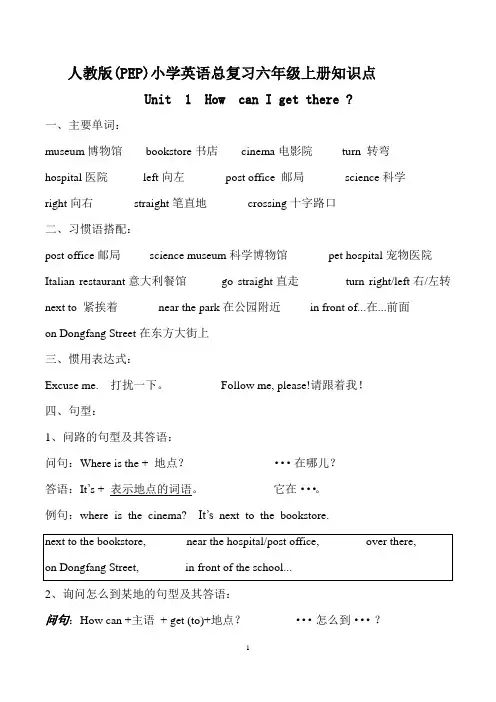
人教版(PEP)小学英语总复习六年级上册知识点Unit 1 How can I get there ?一、主要单词:museum博物馆bookstore书店cinema电影院turn 转弯hospital医院left向左post office 邮局science科学right向右straight笔直地crossing十字路口二、习惯语搭配:post office邮局science museum科学博物馆pet hospital宠物医院Italian restaurant意大利餐馆go straight直走turn right/left右/左转next to 紧挨着near the park在公园附近in front of...在...前面on Dongfang Street在东方大街上三、惯用表达式:Excuse me. 打扰一下。
Follow me, please!请跟着我!四、句型:1、问路的句型及其答语:问句:Where is the + 地点?···在哪儿?答语:It’s + 表示地点的词语。
它在···。
例句:where is the cinema? It’s next to the bookstore.next to the bookstore, near the hospital/post office, over there,on Dongfang Street, in front of the school...2、询问怎么到某地的句型及其答语:问句:How can +主语+ get (to)+地点?···怎么到···?例句:How can I get to ZhongShan park? How can I get there?同义句型:Can you tell me the way to +地点?Where is + 地点?Which is the way to +地点?答语:Turn +方向(left/right)+表示地点的介词短语。
新版PEP小学英语六年级上册1-6单元知识点总结
六年级PEP上册知识总结Unit1 How can I get there?library 图书馆post office 邮局hospital 医院turn left 左转places: cinema 电影院(地点) bookstore 书店go straight 直行science museum科学博物馆crossing 十字路口 turn right 右转supermarket 超市school 学校一、描述某地点所处位置的短语near 在…..附近 next to 与…..相邻beside 在…..旁边 in front of 在……前面behind 在…..后面 between 在…..之间二、问路1.Where is the cinema, please? 请问电影院在哪儿?next to the hospital. 在医院的旁边。
in front of the school. 在学校的前面.behind the park 在公园的后面It’s near the zoo. 在动物园的附近.far from here. 离这儿很远.2. Excuse me, is there a cinema near here 请问这附近有电影院吗?Yes, there is. /No,there isn’t. 有./没有。
3. How can I/we get there? 我怎样到那儿?Turn left at the bookstore. 到书店左转4. How can I get to the hospital? 我该怎样到达医院呢?Take the No.57 bus. 乘坐第57路公汽。
By the No. 57 bus.注意:到那儿 get there到某地 get to Canada/Australia/Beijing/ Shanghai/Wuhanget to the hospital/zoo/bookstore二、指引路1. You can take the No.32 bus. 你可乘坐312路公交车去那儿.注意:You can go by the No.32 bus. 与上句意思一样,只是说法不同。
人教版PEP小学英语六年级上册知识点归纳
人教版PEP小学英语六年级上册知识点归纳人教版PEP小学英语六年级上册是学生在英语学习的过程中关键的一个阶段。
在这个阶段,学生将进一步巩固和扩展之前所学的知识,提高听说读写综合运用的能力。
下面将对该学期的知识点进行归纳和总结。
一、日常对话在六年级上册,学生将继续学习日常对话,并能熟练运用。
这其中包括问候、介绍自己和他人、询问时间和日期等。
学生需要通过大量的练习来牢固掌握这些对话的内容和用法。
二、单词记忆单词记忆在英语学习中起着重要作用。
在这个学期,学生将学习更多的单词,并能正确拼写和运用。
记忆单词时,学生可以通过分类、联想和多次重复等方法进行巩固。
三、句型构建学生在六年级上册将进一步学习句型构建,并能应用到实际生活中。
这其中包括肯定句、否定句、疑问句和简单的复合句等。
通过大量的练习,学生能够熟练地运用这些句型,提高口语表达和书写能力。
四、语法知识在语法方面,学生将学习更多的语法知识,如动词时态、代词、形容词、副词、名词等。
通过掌握基础的语法知识,学生能够更准确地表达自己的意思,语言表达更加流利。
五、阅读理解阅读理解是培养学生阅读能力的重要环节。
在六年级上册,学生将阅读各种题材的文章,并进行相关问题的回答。
通过不断的阅读练习,能够培养学生的阅读理解能力和快速获取信息的能力。
六、听力训练听力训练对学生的英语听力理解能力起着至关重要的作用。
学生需要通过听取各种对话、短文和音频材料,进行听力训练和理解。
通过多次的听力练习,能够提高学生的听力效果。
七、口语表达在口语表达方面,学生需要进行相应的练习和提高。
可以通过角色扮演、对话练习、口头介绍等方式来培养学生的口语表达能力。
鼓励学生踊跃参与课堂活动和英语角,主动与他人交流使用英语。
八、写作训练写作是学生综合运用英语能力的重要环节。
在六年级上册,学生将学习写作信件、日记、便条等。
通过写作训练,能够提高学生的写作能力和表达能力。
九、评价和反思学生需要根据自己的学习情况进行及时评价和反思,了解自己的进步和不足之处。
人教版PEP英语六年级上册知识点归纳
Unit 1 How can I get there?1. 名词: science 科学 museum 博物馆 bookstore 书店 cinema 电影院 hospital 医院 crossing 十字路口2. 动词: turn 转弯3. 副词: left 左 right 右 straight 笔直地4. 短语: post office 邮局1. 名词: sir 先生 restaurant 餐馆 pizza 比萨饼 street 大街;街道 GPS 全球(卫星)定位系统2. 动词: ask 问 feature 特点 get 到达 gave(give 的过去式) 供给;交给 follow跟着tell 告知3. 形容词: interesting 好玩的 Italian 意大利的 far 较远的1. — Where is the cinema? 电影院在哪儿?— It ’ns e xt to the bookstore. 紧挨着书店。
2. How can we get there?我们怎么到那儿?3. Turn left at the bookstore. Then turn right at the hospital.到书店左转。
然后到医院右转。
留意:要留意介词的固定搭配。
Turn left/right at the … 到……左/右转。
Get off at the … 在……下车。
一、核心词汇二、了解词汇三、核心句型It’s on the left/right.在左/右边。
Walk/Go straight for …minutes.步行/直走……分钟。
It’seast/west/south/north of the …在……东/西/南/北边。
It’sfar from the …距离……远。
四、了解句型1.Is there a …?……有……吗?拓展: there be 句型(1)主要用以表达“某处(某时)有某人(某物)”,其根本句型为“There+be 动词+名词+介词短语+其他.”There is a football under the chair. 椅子下面有一个足球。
人教版PEP小学英语六年级上册重点句型及语法知识汇总
人教版PEP小学英语六年级上册重点句型及语法知识汇总Unit 1 How can I get there?重点单词XXX。
post office邮局,XXX。
XXX。
XXX。
crossing十字路口。
turn left左转。
turn right右转。
gostraight直走。
map地图。
compass指南针。
GPS全球定位系统。
stars星星。
XXX意大利餐厅。
getto到达。
重点句型1.---Where is the restaurant?餐厅在哪里?It’s next to the park on Dong fang Street.它在东方路,在公园附近。
2.---How can we get there?我们怎么去哪里?XXX left XXX.书店左转,然后病院右转。
3.He now has GPS.他现在有GPS。
4.What an interesting film!何等风趣的片子!方位词复:XXX紧挨着,near在。
邻近,XXX在。
背面,XXX在。
旁边,in front of在。
前面。
Unit 2 Ways to go to school重点单词on foot走路。
by bike骑车。
by bus乘公交。
by train乘火车。
XXX乘地铁。
by ship搭船。
by XXX乘飞机。
slow down 慢下来。
XXX交通灯。
traffic rules交通划定规矩。
go/come to school上学。
by sled坐雪橇。
byferry坐轮渡。
pay n to留意。
traffic lights交通灯。
and wait at a red light红灯停等一等。
slow downand。
at a yellow light黄灯减速并停下。
Go XXX。
重点句型1.---How do you come to school?你怎么上学?----Usually。
I come on foot.通常我走路来的。
